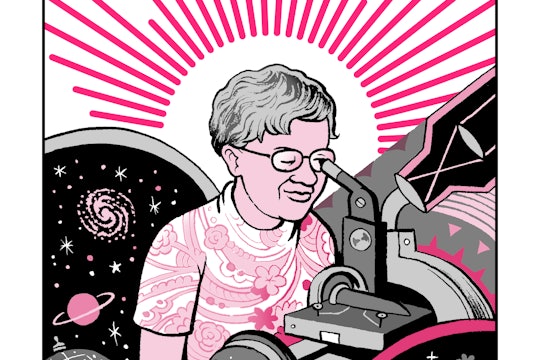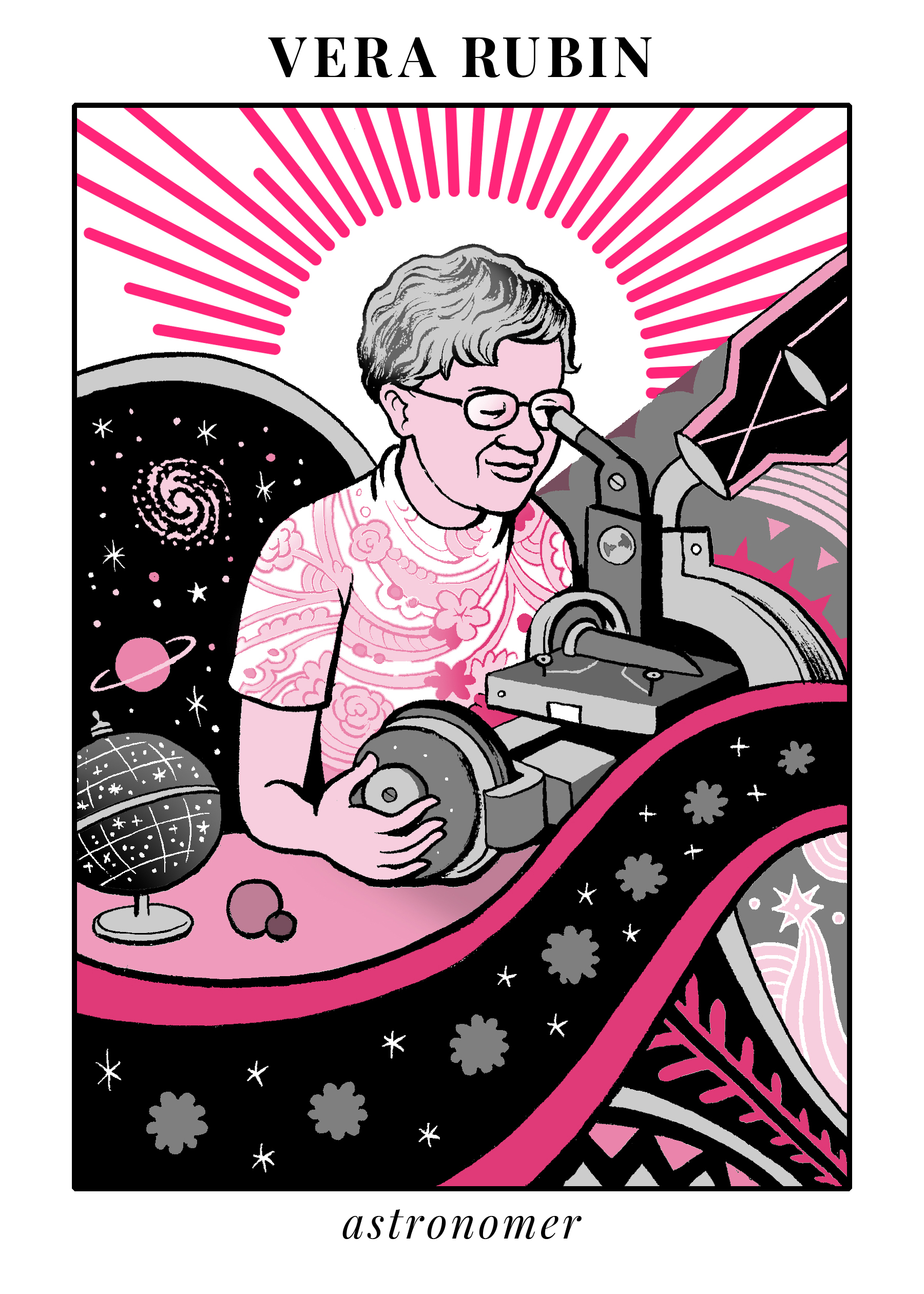
Matteo Farinella
Meet Vera Rubin, the stargazer who predicted dark matter
From childhood, she preferred 'to stay up and watch the stars than go to sleep'
In the 1970s, Vera Rubin discovered that stars on the outskirts of galaxies travelled much faster than predicted by the law of gravity. The only plausible explanation is that galaxies have much more mass than could be inferred from visible stars alone.
That extra mass became known as “dark matter,” the elusive, invisible, as-of-yet unobserved thing that scientists mostly agree makes up 90 percent of the universe. It was a fundamental, seismic shift in our understanding of the universe, akin to realizing that the Earth revolved around the Sun and not the other way around.
At the time of her death in 2016, Rubin was a long-time member of the National Academy of Science (elected 1981), and had received a host of prestigious awards, including the Gold Medal of the Royal Astronomical Society and the National Medal of Science from President Bill Clinton. She also held honorary doctorates from a slew of institutions, including those that had once rejected her as a prospective graduate student for being a woman. Vera Rubin was often the subject of Nobel Prize gossip, but like many eminent women scientists, never made it to give a keynote lecture in Stockholm. Like the universe full of invisible, dark matter, there was a lot more to Vera Rubin than the awards that did (or didn’t) appear on her C.V.

Matteo Farinella
She was a stargazer from an early age
If you ask a bunch of fourth graders what they want to be when they grow up, some of them will invariably say astronauts. They want to explore to universe, to go to the Moon, or to fly in a rocket ship. They wonder what’s out there behind the stars. On clear nights in 1930s Washington DC, 10-year-old Vera Rubin glazed out her bedroom window and counted the stars. Transfixed, she swore she felt the Earth spin beneath her, and sensed the stars shift just a little bit with each passing hour. She’d memorize their movements as she drifted off to sleep, and draw their paths in the sky the next morning. By about age 12, she said in a 1989 interview, "I would prefer to stay up and watch the stars than go to sleep."
Enlisting the help of her father, who was an electrical engineer, she fashioned a telescope out of an Edmund’s brand lens and cardboard tube. It didn’t work, but by the time Vera entered high school, she knew she wanted to be an astronomer.
She battled sexist norms through her career
Vera Rubin graduated from Vassar College as the only astronomer in her class. She applied to some excellent graduate programs, including Princeton, which wrote back that they did not accept women and declined to send her a course catalog. She eventually settled on Cornell, where she earned a MSc in 1951, before moving onto Georgetown University, where she graduated with her PhD in 1954 under the supervision of astrophysicist George Gamow. She faced casual sexism throughout her professional career, including one incident when she had to meet her doctoral advisor in the lobby of his building because the upstairs offices were considered inappropriate places for women.
She held a variety of academic appointments over the years, the most famous being her prolonged stint at the Carnegie Institute, where she was among the first women to battle for access to a 82-inch telescope on Palomar Mountain, CA. The research center was a notorious man cave, a fact reflected by the complete lack of women’s restrooms on campus. She quietly taped the outline of a women’s skirt to the image of a man on restroom door and claimed the space as her own. Many of the observations supporting the existence of dark matter were made at Carnegie, using a custom optical spectrograph built by her close collaborator, Kent Ford.
She remained a staunch advocate and mentor for women in science throughout her career, even at times when the glass ceiling was more like a concrete wall. She was known for being encouraging and inspirational, but also for throwing her weight around when it mattered. She pressed committees to consider female candidates for faculty positions, awards, honors, and to be invited speakers. She would give conference organizers hell if she sensed female speakers were underrepresented.
When asked what she thought prevented some women from going into science, she emphasized cultural factors and drew upon her family as an example. “I think probably it's the way we raise little girls," she said.
I have two granddaughters. One of them … said her toy rabbit was sick. Her uncle said, "Well, you be the doctor and I'll be the nurse, and we'll fix it," and she said, "Boys can't be girls." And her mother realized that she never had seen a doctor who was a woman. By the age of two, she knew that men were doctors and women were nurses. Somehow or other, you have to raise little girls who have enough confidence in themselves to be different.
She probably wouldn't say she discovered dark matter
Rubin’s dark matter findings are based upon the observed rotational speed of galaxies and estimations of their mass – no one has ever been able to directly observe dark matter in action to confirm its existence. Capture or detection of a dark matter particle and characterization of its physical properties remains an elusive goal. Rubin predicted in 1980 that a dark matter particle would be found within a decade. It became a running joke of sorts – every few years she would revise her prediction that dark matter would be discovered in the next 10 or – if she was feeling especially ambitious – five years. Rather than become frustrated as her field searched for a ghost, the lag excited her.
Rubin was a fervent subscriber to the scientist’s philosophy. You don’t set out to ‘prove’ something exists; you set out to gather the best data, observe, and let it shape your arguments. In that paradigm, she discovered evidence for the existence of dark matter, rather than the thing itself.
"We're still groping for the truth," she said, in that 1989 interview. "I think as telescopes get bigger, and astronomers get cleverer, all kinds of things are going to be discovered that are going to require alterations in our theories.”
Even the most starry-eyed and idealistic graduate student would have trouble matching such integrity and faith in scientific method.
